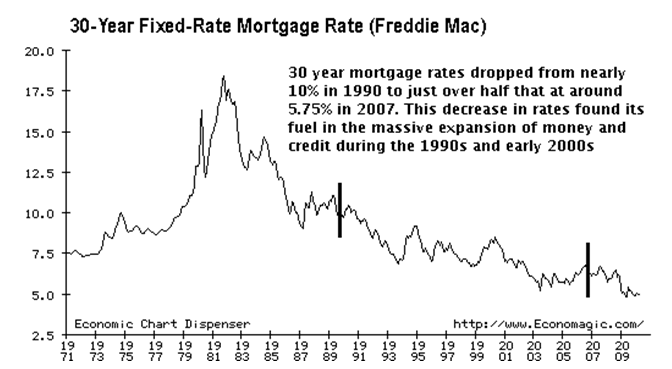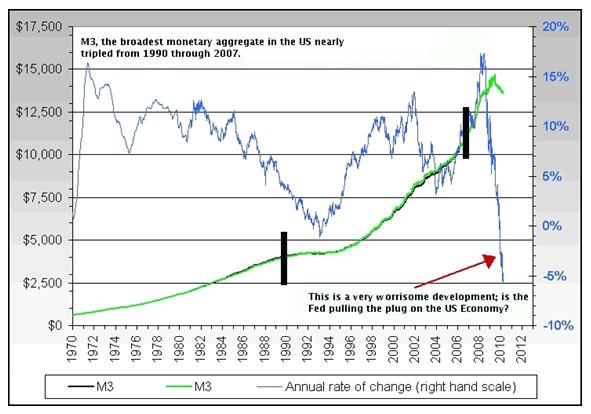Deflation, Inflation, Hyperinflation, Bubbles and Gold
Economics / Liquidity Bubble Apr 09, 2010 - 01:10 PM GMTBy: Andy_Sutton
 Sometimes a picture really is worth a thousand words, even if it is only to prove a point that common sense dictates should have been won a long time ago. But common sense seems to be in short supply and not only has the point not been won, it isn’t even being discussed right now. Yes, it is the age-old debate on where price inflation comes from. It is also a foregone conclusion that the US is heading towards a Weimar style hyperinflationary depression. Left to normal circumstances, that is logical conclusion. However, there are several developments that point to the possibility of another deflationary depression, similar to the 1930’s. We’ll get to that later. For starters, let’s put to bed (hopefully) once and for all where price inflation comes from.
Sometimes a picture really is worth a thousand words, even if it is only to prove a point that common sense dictates should have been won a long time ago. But common sense seems to be in short supply and not only has the point not been won, it isn’t even being discussed right now. Yes, it is the age-old debate on where price inflation comes from. It is also a foregone conclusion that the US is heading towards a Weimar style hyperinflationary depression. Left to normal circumstances, that is logical conclusion. However, there are several developments that point to the possibility of another deflationary depression, similar to the 1930’s. We’ll get to that later. For starters, let’s put to bed (hopefully) once and for all where price inflation comes from.
Inflation
There are two camps and they argue bitterly. One claims that prices rise because of supply and demand factors (which is partially true) and as a function of a healthy economy, which is patently false. The other side argues correctly that prices rise because the supply of money and/or credit has increased - effectively monetizing demand, which pushes up price levels. Some analysts have argued that there is no inflation because the price of electronics always seems to drop. In the second half of 2008 they argued that there was no inflation because petroleum prices were falling. They made the tragic mistake of substituting a single good for the concept of ‘general price level’.
It is categorically impossible for general price levels to increase in the long run without a commensurate increase in the supply of money and credit. It is important here to make the distinction between short and long run. In the short run, an increase in general prices can be absorbed without a growth in the money supply because it could, in theory, be sustained by devouring savings. But in practice, generally speaking, that isn’t how things work. People tend not to expand spending unless they feel comfortable that money and (particularly) credit are readily available. The housing bubble of the early 21st century is a prime example.
Bubbles
Out of fear of destroying a very easy point, I am going to let the three charts shown below along with a very brief narrative speak for themselves. Then you decide what fueled the housing bubble, and drove up house prices along with general price levels.

As can easily be seen in the above chart, 30-year mortgage rates dropped steadily from 1981 through the present. Not surprisingly, low rates and readily available credit led to a massive price expansion by monetizing demand.

Clearly the expansion in money had to come from somewhere to fuel lower mortgage rates and the expansion in home prices. The chart below, with brackets for the 1990-2007 period shows exactly where it came from. M3 in the US nearly tripled during that 17-year period.

Deflation??
One thing that should be utterly frightening is the recent freefall of M3 growth. Most folks understand that inflation has been responsible for the vast majority of our economic ‘growth’ over the past century. Inflation fueled the dotcom and real estate bubbles. In short, our economy is set up to run in an inflationary environment. Unfortunately, there is a predictable end to this scheme. At some point, the monetary environment devolves into hyperinflation, then a deflationary collapse. We certainly haven’t experienced hyperinflation yet in the US, and we know the Fed can win a battle with deflation because it can create as much money as is necessary to overwhelm deflationary forces. The current Chairman didn’t get his nickname because he used to fly puddle jumpers. So we’re left to ask: what exactly is going on here?
I think the answer lies in the fact that there are roughly 20 countries right now that are on the verge of bankruptcy and an outright default - the US and UK among them. The US clearly isn’t the only nation in hot water with debt. Greece is a pitifully minute example of what is really a systemic problem for much of the West. In my opinion, we are likely moving towards a coordinated outright default, which will involve the devaluation of currencies followed by central banks capping money growth, which in turn will trigger a second deflationary depression. Most people realize that we now have a fiscal gap of around $100 Trillion just in the US alone. It cannot be filled via conventional means consisting of tax increases and program cuts.
I and many others wrote years ago that we needed to address those issues right then or lose our chance. We didn’t do it. There are two choices now: hyperinflation or default. While the collapse in M3 growth does not yet constitute de facto proof that we’re headed for the default scenario, it is certainly something that has to be considered. The good news in that scenario is that cash money would be worth more because it would be in short supply. The bad news is that there won’t be enough of it to maintain our current standard of living – especially in a situation where there is a concurrent devaluation.
Gold
Many will be wondering how I can be an advocate of Gold and Silver in such an environment? The benefits of precious metals are well documented in the case of hyperinflation, but not so much so in the case of deflation. It is a pretty simple and logical conclusion that if there is a shortage of cash, then the presence of cash ‘substitutes’ will be very beneficial. This is especially true in local commerce as in the 1930’s when many areas saw the widespread use of ‘co-ops’ or local trading blocs. The rationale for holding precious metals will be different than if we experience hyperinflation, and their use would be different as well, but I think it is foolish to assume that they’d be a detriment in either case.
Hopefully everyone reading this understands the importance of watching the monetary aggregates for clues as to what is coming down the road. Thanks to nowandfutures.com for providing the continuation of the M3 series depicted in the chart above. Ultimately, our monetary destiny now lies in the hands of global banking interests. We will proceed down the path that best serves them, not our national interest. Congress abdicated its responsibility for our money, as outlined in Article 1, Section 8 of the US Constitution, when it passed the Federal Reserve Act back in 1913. The best thing this Congress could do with the rest of its time is craft and pass legislation to repeal that Act in its entirety.
This tax day, April 15th, we’ll be releasing the next issue of The Centsible Investor. Our focus this month will be on the President’s Working Group on Financial Markets, aka the Plunge Team. We’ll also examine the prospects for $100 oil and analyze a company that makes its money selling electrical generation, process automation, and a vast array of other products to industries ranging from petroleum exploration and pharmaceuticals to automobile manufacturers. Don’t miss it! Click Here for more information.
By Andy Sutton
http://www.my2centsonline.com
Andy Sutton holds a MBA with Honors in Economics from Moravian College and is a member of Omicron Delta Epsilon International Honor Society in Economics. His firm, Sutton & Associates, LLC currently provides financial planning services to a growing book of clients using a conservative approach aimed at accumulating high quality, income producing assets while providing protection against a falling dollar. For more information visit www.suttonfinance.net
Andy Sutton Archive |
© 2005-2022 http://www.MarketOracle.co.uk - The Market Oracle is a FREE Daily Financial Markets Analysis & Forecasting online publication.



